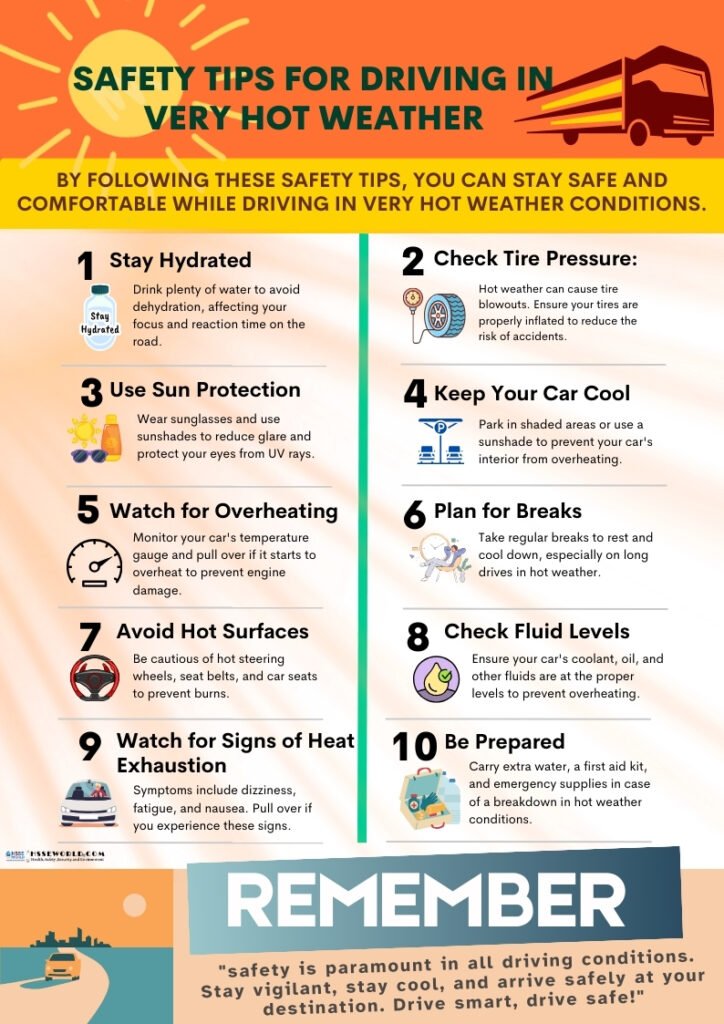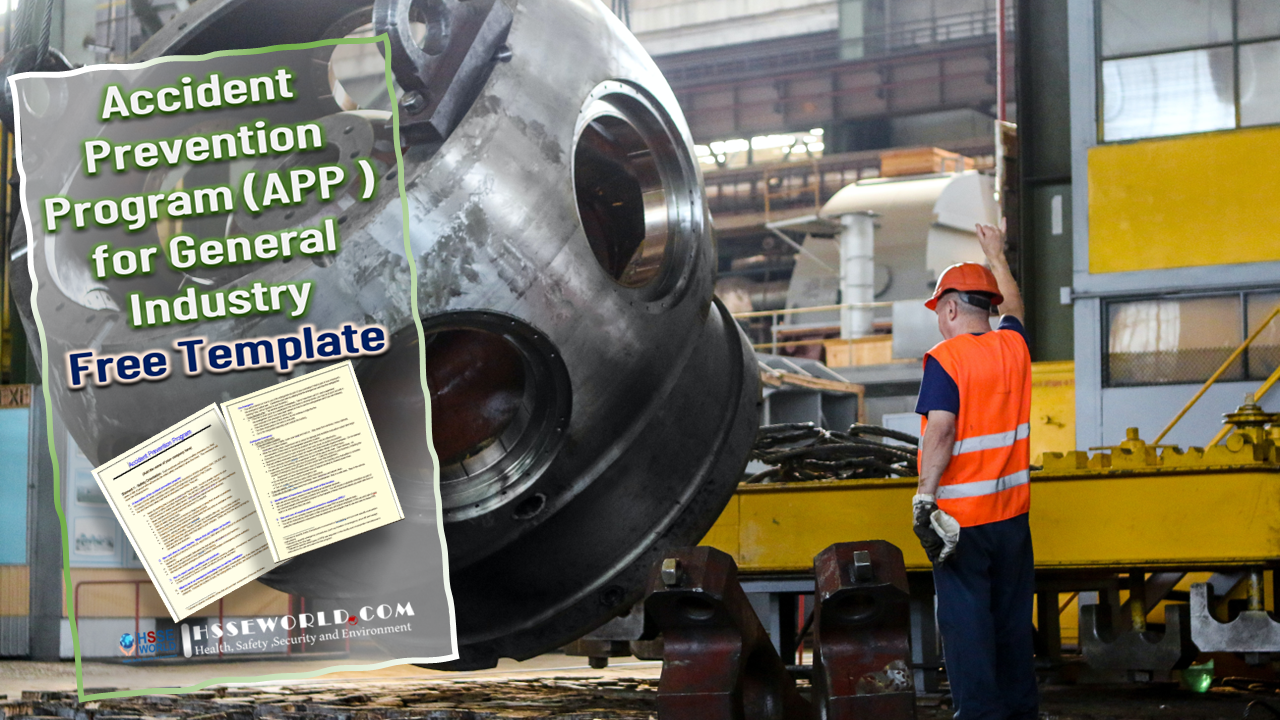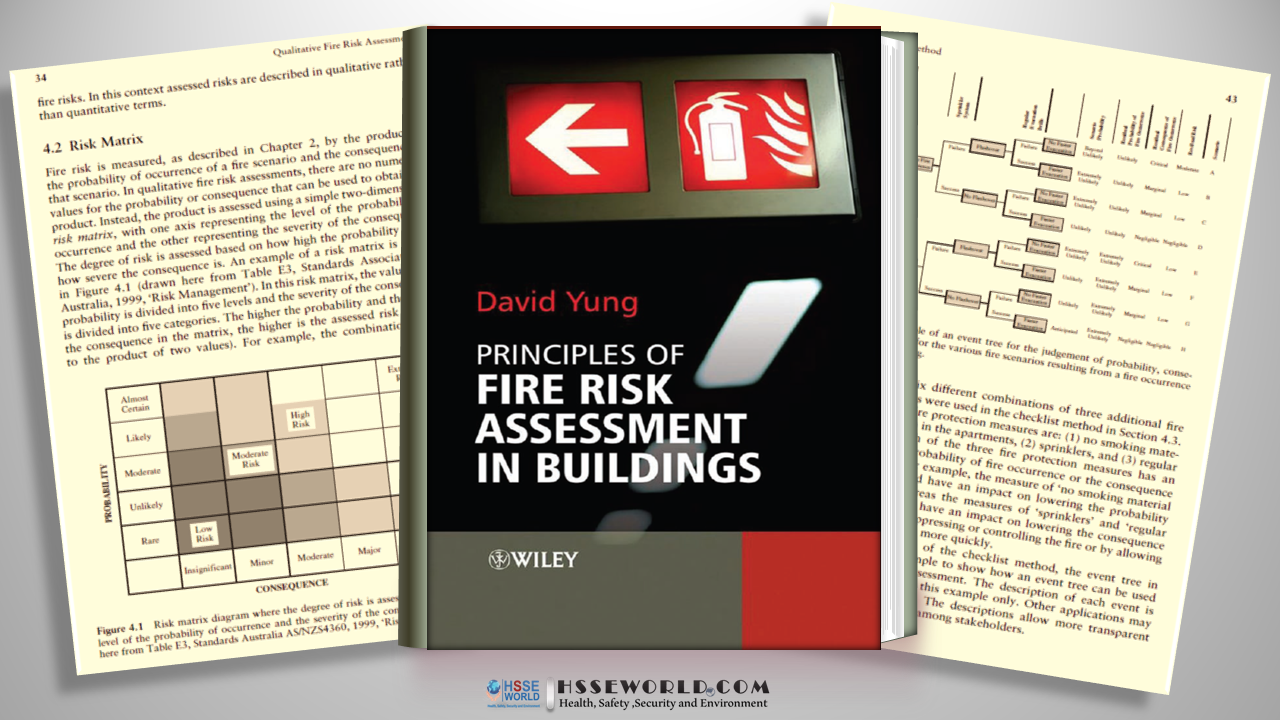As the summer heat intensifies, it’s important to be well-prepared and equipped with the knowledge to ensure safety and comfort on the road. Driving in extremely hot weather conditions can present unique challenges, from dehydration and tire blowouts to overheating engines and burn risks. In this blog post and our Infographic ” Safety tips for Driving in hot weather conditions,” we will explore ten essential safety tips that will help you navigate the scorching temperatures while promoting workplace safety and personal well-being.
Also, Read: Photo of the day: Tips to reduce Heat stress in the workplace

Understanding Heat-Related Vehicle Problems
Extreme heat can adversely affect your vehicle, causing various components to malfunction or deteriorate at a faster rate than under normal temperatures. One must grasp these potential issues to ensure preventative measures are in place and to avoid being stranded in scorching weather conditions.
- Cooling System Failures: The cooling system keeps the engine from overheating. In high temperatures, coolant fluids can deplete faster, and components like hoses can burst or wear out, leading to overheating. Periodically checking and refilling coolant levels is crucial.
- Tire Blowouts: Tires are especially vulnerable to heat. Excessive heat can cause the air inside tires to expand, leading to overinflation. Combined with hot pavement, this can result in increased tire wear or sudden blowouts. Monitoring tire pressure is key during hot conditions.
- Battery Stress: Heat can hasten the chemical reaction inside a vehicle’s battery, leading to a quicker depletion of battery life. Keeping the battery clean and checking its charge can help prevent unexpected failures.
- Oil Viscosity and Consumption: High temperatures can thin engine oil, reducing its effectiveness. Ensure regular oil checks and changes to keep the engine lubricated properly.
- Fuel System Issues: Heat can cause fuel to evaporate faster from the gas tank, especially if there are leaks in the fuel system. Regularly inspecting the fuel lines and cap for signs of wear or damage can prevent fuel loss and potential fire hazards.
Preparation: Vehicle Safety Checks Before Hitting the Road
Proper vehicle maintenance is critical to ensure a safe trip, particularly in scorching weather conditions. Here are essential safety checks to perform before departing:
- Tire Inspection: Examine the tire tread depth, signs of uneven wear, and sidewall cracks. Check the tire pressure, including the spare, as higher temperatures can cause the air inside tires to expand, leading to over-inflation.
- Cooling System: Verify the coolant level and concentration. Inspect hoses and belts for signs of wear or leaks. A properly functioning cooling system prevents overheating, which can be exacerbated by high external temperatures.
- Engine Oil and Fluids: Check oil levels to ensure optimal lubrication and cooling of the engine. Also, inspect transmission fluid, brake fluid, power steering fluid, and windshield washer fluid.
- Battery Performance: Heat accelerates battery fluid evaporation, leading to corrosion on terminals and connections. Ensure the battery is secure and free of corrosion.
- Air Conditioning: Test the air conditioning system for proper cooling function. If the system is underperforming, it may require a recharge or repair, which is vital for driver and passenger comfort and safety during heat waves.
- Lights and Signals: Confirm that headlights, brake lights, turn signals, and hazard lights are in working order for visibility and communication with other drivers.
- Wiper Blades: Ensure wiper blades are effective and not brittle or cracked. Poor visibility due to malfunctioning wipers can be dangerous during sudden summer showers.
- Emergency Kit: Update the emergency kit with plenty of water, sun protection, a basic tool set, reflective warning signs, and a fully charged mobile phone for emergencies.
These pre-emptive measures can prevent breakdowns and accidents, and they’re a responsible part of trip planning in extreme weather conditions. Remember, vehicle safety is paramount in safeguarding you and your passengers on the road.
Staying Hydrated: Essential Fluids for You and Your Car
Driving in scorching weather conditions puts a strain not just on the driver but also on the vehicle. Maintaining proper hydration is crucial for both to function effectively.
For the driver, dehydration can lead to a decrease in concentration, increased fatigue, and slower reaction times. It is recommended to:
- Drink water regularly: Carry a reusable water bottle and sip frequently.
- Avoid caffeinated beverages: These can lead to dehydration.
- Recognize the signs of dehydration: Such as dry mouth, headaches, and dizziness.
For the vehicle, the heat can cause essential fluids to evaporate or break down faster, so it’s important to:
- Check the coolant level: This helps prevent the engine from overheating. Ensure it’s at the proper level and concentration before embarking on a journey.
- Inspect the engine oil: High temperatures can thin out oil, which means it may not lubricate the engine parts sufficiently. Check the oil level and replace it as needed.
- Monitor brake fluid: Brakes can fail due to fluid boiling in extreme heat. Ensure the brake fluid is at the correct level and in good condition.
- Assess transmission fluid: Overheating can also affect transmission performance. Check this fluid regularly to maintain gear function.
- Keep an eye on the power steering fluid: Difficulty steering can be due to low fluid levels in the heat. Verify that it’s filled to the marked levels.
Both the driver and the vehicle rely on fluids for peak performance. Attention to hydration for oneself, and fluid checks for the car, should be part of any pre-travel checklist, particularly when temperatures soar. This will help ensure a safe, comfortable, and uninterrupted journey.
how-to-handle-excessive-heat-exposure-at-work
The Importance of Properly Functioning Air Conditioning
When traversing through scorching weather conditions, a properly functioning air conditioning (AC) system in a vehicle is not just a matter of comfort but of safety. In extreme heat, the interior of a car can reach dangerously high temperatures, posing a risk of heat stroke and dehydration to the occupants. Here are several reasons why maintaining an efficient AC is crucial during hot weather driving:
- Heat-related Illness Prevention: A working AC helps to reduce the cabin temperature, protecting drivers and passengers from heat exhaustion and heatstroke, which can impair cognitive and motor functions, increasing the risk of accidents.
- Improved Air Quality: AC systems filter out pollutants and allergens from the air entering the cabin. Clean, cool air is vital for maintaining driver alertness and passenger comfort.
- Better Visibility: AC helps in demisting windshields by removing the excess moisture from the car’s interior, thereby improving visibility and reducing the likelihood of collisions.
- Preservation of Electronics: High temperatures can damage the electronics within a vehicle. AC helps in maintaining a cooler environment that protects these systems.
- Stress Reduction: Driving in uncomfortably hot conditions can increase stress levels, which may lead to aggressive driving and a decreased ability to make prudent decisions on the road.
- Efficiency and Longevity: Regularly servicing the AC ensures it works efficiently and prolongs its life, avoiding potential breakdowns that could leave you stranded in the heat.
It is imperative to ensure that the AC system is in good working order before setting out on a journey in hot weather. This can be achieved through regular maintenance checks, including refrigerant level inspection and air filter replacement. A well-maintained AC not only safeguards your well-being but also enhances your overall driving experience under the blazing sun.
Protecting Your Vehicle’s Interior from Extreme Heat
The interior of a vehicle can suffer significantly in extreme temperatures, but certain measures can mitigate damage and maintain comfort. Reflective windshield sun shades are a key first step. By placing these shades behind the windshield when parked, drivers can reduce the internal temperature, protecting the dashboard, steering wheel, and upholstery from sun damage.
Tinting automobile windows, within the legal limits, can block a substantial amount of heat-causing UV rays from entering the vehicle. If window tinting is not an option, using removable window shades can provide similar protection, especially for car seats and rear interiors.
High heat can lead to the faster deterioration of leather and other materials. Regularly conditioning leather seats and applying protectant on other surfaces can preserve the interior. Conditioners and protectants act as a barrier against the sun’s drying effects, reducing cracks and preserving color.
Parking in the shade greatly reduces the vehicle’s exposure to direct sunlight, but if shade is not available, even leaving the car parked with windows slightly open can allow hot air to escape. However, one should always ensure that this does not compromise vehicle security.
Effective use of vehicle cabin ventilation or starting the car and activating the air conditioning a few moments before driving can also reduce the interior temperature. This practice makes the environment more comfortable for passengers and reduces the strain on the air conditioning system that may occur when it has to cool an excessively hot cabin.
By implementing these strategies, drivers can protect their vehicle’s interior from the damaging effects of extreme heat and ensure a more pleasant and safe traveling experience in scorching weather conditions.
Effective Use of Sunshades and Window Tints
In the relentless battle against scorching weather conditions, sunshades and window tints are potent weapons for maintaining your vehicle’s internal temperature. Sunshades can be placed on the windshield and rear windows of a vehicle when parked to reflect sunlight and reduce the build-up of heat inside the vehicle. They can be especially useful in preventing the steering wheel and seats from becoming excessively hot, making the driving experience upon re-entry more comfortable.
Window tints, on the other hand, serve a dual purpose. While they are primarily known for providing privacy, the right kind of tints can also block a significant percentage of ultraviolet (UV) rays and infrared (IR) radiation, responsible for heating the vehicle’s interior. Here are some considerations for their effective use:
- Ensure that window tints comply with state laws, as regulations on the level of darkness allowed can vary widely.
- Choose tints that have clear labels indicating their UV and IR blocking capacity.
- Consider professional installation of tints to avoid bubbles and peeling, which can impair visibility.
- Avoid using sunshades while driving, as they impede visibility. They should only be placed on windows when the vehicle is parked.
Additionally, it’s worth noting that both sunshades and tints aid in protecting the car’s interior from long-term sun damage. Fabrics, leather seats, dashboards, and other components can fade or crack over time when exposed to direct sunlight. Therefore, implementing these tools not only contributes to immediate comfort but also maintains the integrity and value of the vehicle’s interior in the long run.
Driving Strategies to Avoid Overheating the Engine
When driving in scorching weather conditions, the engine can easily become your vehicle’s Achilles heel if not monitored and maintained appropriately. Overheating not only puts a damper on your travel plans but can also cause significant damage to the engine. Here are some strategies to help prevent your car’s engine from overheating:
- Monitor the temperature gauge: Keep an eye on the dashboard’s temperature gauge. A needle creeping towards the red zone is a telltale sign of an overheating engine. Should the gauge indicate an overheating condition, immediately take steps to cool down the engine.
- Use air conditioning wisely: Running the air conditioning (A/C) puts an additional load on the engine. If the temperature gauge starts to rise, turn off the A/C to reduce the strain on the engine.
- Maintain the cooling system: Regularly check and maintain the coolant levels. Before the start of the summer season, it is advisable to have your vehicle’s cooling system flushed and the coolant replaced.
- Turn on the heater: It may seem counterintuitive, but turning on the heater can draw heat away from the engine and help in lowering the temperature.
- Avoid idling and stop-and-go traffic: Extended periods of idling or slow-moving traffic can cause engine temperature to rise. If possible, choose routes that allow for a constant flow of traffic.
- Manage the engine load: Heavy loads increase engine strain and temperature. Towing trailers or carrying heavy roof-top loads in hot weather should be avoided if possible.
- Regular maintenance: Ensure the engine’s belts and hoses are in good condition. A broken belt or a leak in a hose can lead to an overheated engine. Additionally, check the timing and operation of the engine’s cooling fan.
- Pull over if necessary: If the engine is overheating and none of the above strategies are effective, safely pull over and turn off the engine. Allow the engine to cool before attempting to check or service any components.
By adhering to these strategies, drivers are more likely to keep their engines running at optimal temperatures, even in extreme heat, which in turn ensures safe and uninterrupted travels during the summer months.
Recognizing the Signs of Heat Exhaustion While Driving
Heat exhaustion is a serious condition that can occur when the body overheats, typically as a result of prolonged exposure to high temperatures. This is especially relevant for drivers who may be in a hot vehicle for an extended period. It is crucial for drivers to recognize the signs of heat exhaustion to ensure their safety and that of others on the road. Here are several indicators to watch for:
- Excessive Sweating: While it may be common to perspire in hot weather, an unusual amount of sweating may be the body’s response to overheating.
- Weakness or Fatigue: Feeling unusually tired or weak while driving could signal that your body is struggling with the heat.
- Dizziness or Fainting: These are alarming signs that should not be ignored. They may indicate that the body is not coping well with the temperature.
- Muscle Cramps: Pay attention to any muscle spasms or cramps, which can occur when the body loses electrolytes through sweat.
- Headache: A throbbing headache can be a precursor to more serious heat-related issues.
- Nausea or Vomiting: An upset stomach or the urge to vomit are clear signs that you may be experiencing heat exhaustion.
- Rapid Heartbeat: An increase in heartbeat that isn’t caused by physical exertion should be noted, especially if accompanied by other symptoms.
It is imperative to take immediate action if any of these symptoms are experienced while driving. This includes pulling over safely at the earliest opportunity, turning on the air conditioning or opening windows to cool the vehicle, hydrating with water, and taking a break from driving until the symptoms subside. If symptoms do not improve or worsen, seek medical attention promptly. Remember, heat exhaustion can swiftly escalate to heat stroke, which is a life-threatening condition.
Keeping Children and Pets Safe in Hot Weather Conditions
In scorching weather conditions, vehicles can become deathly hot very quickly, even with the windows slightly open. It is paramount to prioritize the safety of children and pets, as they are highly susceptible to heatstroke. Here are essential tips to ensure their safety:
- Never Leave Children or Pets Inside the Car: Even during short errands or if you believe the temperature outside isn’t too high, the temperature inside a parked car can escalate dangerously within minutes.
- Always Check the Backseat: Establish a routine to check the backseat before locking the vehicle, to ensure no child or pet is accidentally left behind. A good practice is to leave a necessary item like a purse or briefcase in the backseat as a reminder.
- Educate Children: Teach children that cars are not play areas and they should never enter a vehicle alone. Keep vehicle doors and trunks locked when not in use, and keep keys out of children’s reach.
- Provide Adequate Ventilation for Pets: When transporting pets, ensure they have enough fresh, cool air. Consider using window shades or cooling mats, and never rely on the car’s air conditioning system when you are not in the vehicle.
- Stay Informed: Know the signs of heatstroke – in children, these include high body temperature, red skin, rapid breathing, restlessness, and confusion; in pets, look for heavy panting, difficulty breathing, increased heart and respiratory rate, drooling, and weakness.
- Act Quickly: If you see a child or pet alone in a hot car, act immediately. Call emergency services and follow their instructions. You could save a life.
Safety comes first, especially in extreme temperatures. By adhering to these guidelines, the wellbeing of children and pets can be guarded against the dangers of hot weather conditions.
Navigating through Sudden Overheating: Steps to Take
If a driver notices their car’s temperature gauge spiking or steam billowing from under the hood, immediate action is needed to handle the sudden overheating. Here are the steps to take:
- Pull Over Safely: As soon as it is safe to do so, drivers should guide their vehicle to the side of the road and turn on hazard lights.
- Turn Off the Engine: To stop further damage, the engine should be shut off immediately after the car is safely parked.
- Do Not Open the Hood Immediately: Opening the hood right away can be dangerously hot. Wait for the engine to cool down before attempting to look under the hood.
- Check the Coolant Levels: Once the engine has cooled, check the coolant reservoir. If it’s low, a careful top-up might be required; however, don’t remove the radiator cap while the engine is hot.
- Look for Leaks: Inspect for any visible leaks in the cooling system. Leaking coolant could be a sign of a blown hose or a more serious issue.
- Call for Help: If the overheating issue is not resolved by adding coolant or if the cause is not immediately apparent, call for roadside assistance or a tow to a qualified mechanic.
- Do Not Attempt to Drive: Continuing to drive an overheated vehicle can cause severe damage to the engine. Waiting for professional help is the safest course of action.
- Monitor Temperature Gauge: If the situation calls for a brief drive to reach a safer location, keep an eye on the temperature gauge. Should it rise again, repeat the aforestated steps.
Proper maintenance reassures drivers in high temperatures but knowing how to navigate an overheating situation is crucial for safety and could potentially save the engine from extensive damage.
Insurance and Assistance Plans for Heat-Induced Breakdowns
When driving in scorching weather conditions, the risk of vehicular breakdown due to overheating significantly increases. It is vital for drivers to be proactive and ensure that they have adequate insurance and assistance plans in place to address heat-induced problems.
- Comprehensive Car Insurance: Opt for a comprehensive car insurance policy that covers damages due to overheating and other heat-related issues. It should include repair costs for the engine, transmission, and other critical components affected by extreme temperatures.
- Roadside Assistance Coverage: Ensure your insurance package includes roadside assistance. This service can be invaluable if your vehicle suffers a breakdown in the heat. They can provide on-the-spot repairs, towing services, and even transport for the driver and passengers if necessary.
- Cooling System Coverage: Look for insurance policies that specifically offer coverage for your vehicle’s cooling system. As the primary defense against overheating, maintenance and potential repairs of radiators, water pumps, and coolant hoses can be costly and should be covered.
- Rental Car Benefits: In the event your car needs to be serviced due to a heat-induced breakdown, rental car benefits will keep you mobile and minimize disruptions to your schedule.
- Emergency Travel Expense Coverage: Some insurance plans may cover travel expenses resulting from breakdowns during long trips, which can be a lifeline if you’re stranded far from home in sweltering conditions.
- Personalized Assistance Services: Seek out insurance providers that offer personalized assistance services, such as providing alerts for extreme weather conditions that may pose a risk to your vehicle, or offering tips on how to protect your car from heat damage.
Lastly, car owners should regularly review their insurance and assistance plans to ensure that they remain adequately protected as their needs and vehicle usage change over time. Regardless of your driving habits, securing the right insurance and assistance from an insurance broker Calgary can make all the difference when faced with the challenges of driving in scorching weather conditions.
Conclusion: Staying Cool and Collected on the Road
Undoubtedly, driving in scorching weather conditions poses an array of challenges to both the driver and the vehicle. To combat heat-related stress and ensure a safe journey, maintaining a cool and collected demeanor is essential. This can be done by preparing adequately before hitting the road and staying calm and vigilant throughout the journey.
Drivers should:
- Verify that their vehicle’s air conditioning system is functioning optimally for effective cooling throughout the trip.
- Keep a supply of cool beverages within reach, staying hydrated to maintain focus and avoid heat exhaustion.
- Dress in light, breathable clothing to help regulate body temperature during lengthy periods behind the wheel.
- Plan their route with potential rest stops in mind where they can take breaks, stretching and cooling off as needed.
- Apply sun protection, such as high SPF sunscreen and wearing sunglasses, to shield against intensive UV rays.
It is equally crucial to be aware of the car’s temperature gauges continually, watching for any signs of overheating. If the vehicle does overheat, pull over safely and address the issue immediately to prevent further damage.
Furthermore, maintaining a cool temperament in congested traffic, which can be heightened in the heat, is vital. Employing tactics to reduce road rage, such as listening to calming music and practicing deep breathing techniques, is advisable.
In summation, drivers who prioritize safety by respecting weather conditions and managing their stress levels are better equipped to handle the challenges of scorching temperatures on the road. This not only protects them but also ensures the safety and well-being of their passengers and fellow road users.
Download Infographic
Before you leave, do not Miss out Download of the Infographic
More Photos
- What are the Best Practices for Managing Subcontractor Risk
- Photo of the day: 10 Essential Safety Tips for Driving in Hot Weather Conditions
- Photo of the day: best workplace safety tips
- Photo of the day: The Importance of Stop Work Authority in Maintaining Workplace Safety
- Photo of the day: Tomorrow’s Reward for Working Safely Today: Cultivating a Culture of Safety
- Photo of the day: Preventing slips and trips at work
- Photo of the day: Learn the DRSABCD action Plan
- Working with Electricity Electrical Accidents Guide for Electrical Workers
- Photo of the day: Hearing Protection Device Selection
- Photo of the day: If An Earthquake Shakes You-Infographic free
- Fire Safety Posters Free Download
- Photo of the day: First Aid for Electrical Burns-Infographic free
- Infographic: First Aid for Cuts and Scrapes free download
- Photo of The day: Work Safe with Lasers-Laser Safety free
- Photo of the day: Working Safely with chemicals and chemical Management
- Photo of the day: Safe work practices when using MEWPs ( updated)
- Photo of the day: Preventing Common Kitchen Hazards
- Photo of the day: Safe handling of Gas Cylinders and lecture bottles
- Photo of the day: Forklift Stability Triangle
- Photo of the day: Defective Tools Safe Work Practice
- Photo of the day: Lift With Your Legs Not With Your Back
- Photo of the day: First Aid for burns
- Photo of the day: The 7 Principles of HACCP
- Photo of the day: Working Safely with Suspended Loads
- Photo of the day: Heat Stroke First Aid and safety posters
- Photo of the day: Near-Miss Reporting and Posters
- Photo of the day: Ergonomic chair and office chair safety tips
- Photo of the day: Whole Body Vibration
- Photo of the day: Substation Safety Equipment
- Photo of the day: Bypassing Safety Controls Rules
- Photo of the day: Lightning Safety Tips
- Photo of the day: Overhead Power lines Clearance
- Photo of the day: Floor Marking
- Photo of the day: Types of Foot Protection
- Photo of the day: Types of Hand Protection
- Photo of the day: Lockout and Tagout Safety
- Photo of the day: Fall Protection Plans
- Photo of the day: Flood Safety Tips
- Photo of the day: Read All Labels Work safe
- Photo of the day: Run Project safely with Crane Hand Signals
- Photo of the day: Flagman and Traffic control
- Photo of the day: Managing Risks of Exposure to Solvents in the workplace
- Photo of the day: Scissor Lift Safety
- Photo of the day: HSE Bulletin Board
- Photo of the day: Arc-Fault Circuit Interrupters (AFCI)
- Photo of the day: Safe use of ladders and step ladders
- Photo of the day: Concrete Truck Driver Hand Signals
- Photo of the day: Extension Cord Safety Tips
- Photo of the day: Protect your Head
- Photo of the day: choosing the right Anchorage
- Photo of the day: Work-Related Asthma
- Photo of the day: Top FIVE Heavy Equipment Construction Site Safety Tips
- Photo of the day: sun safety in the workplace
- Photo of the day: Cannabis and Impairment in the Workplace
- Photo of the day: Position for safety and comfort-Safety Tips
- Photo of the day: Generator Safety
- Photo of the day: Controlling COVID-19 in the Workplace-Physical Barriers
- Photo of the day: Manual Material handling
- Photo of the day: Personal Protective Equipment last resort
- Photo of the day: WHMIS 2015 – Pictograms
- Photo of the day: Indoor Air Quality
- Photo of the day: Noise in the affected workplace
- Photo of the day: Fatigue at Work
- Photo of the day: Don’t be Driven to Distraction
- Photo of the day: working in heat and Humidex Rating
- How to use Plate Clamps Safely: Safety Moment#34
- Photo of the day: Sitting at work
- Photo of the day: 5 ways to reduce the risk of Slipping and Tripping
- Photo of the day: Preventing the spread of contagious illness
- Photo of the day: Incident Investigations
- Photo of the day: 10 Scaffold Safety Essentials
- Photo of the day: Effective Health and Safety Committees
- Photo of the day: New worker Orientation & Safety Orientation checklist
- Photo of the day: Workplace Inspection
- Photo of the day: musculoskeletal disorders
- Photo of the day: Emergency preparedness in the workplace
- Photo of the day: Mental health in the workplace
- Photo of the day: Trenching Safety Tips That Can Save a Life
- Photo of the day: Dangerous Goods Classes
- Photo of the day: Safety Equipment for Confined Spaces
- Photo of the day: Tips to reduce Heat stress in the workplace
- Photo of the day: hierarchy of controls
- Your steps to chemical safety
- H2S Gas and how to handle its Emergency
- Photo of the day: Importance of Mock drill and Fire Action Emergency Procedure
- Photo of the day: Choosing the Right Face Mask and the difference between a respirator and face mask
- Photo of the day: Confined space safety Precautions
- Breath Safely: The Proper Use of Respiratory Protection
- Photo of the day: Electric shock survival
- Photo of the day: Chemical Spill Emergency Response
- Photo of the day: Construction Site fire Safety
For Many Safety Resources please visit SAFETY BAG





